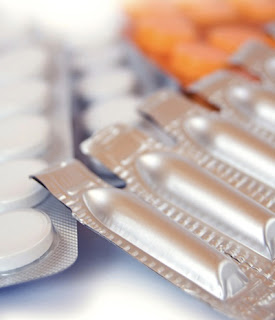 RECTAL DELIVERY
RECTAL DELIVERYAlthough administration via the peroral route is the most commonly targeted goal of new drug and dosage form research and development, oral administration is not always feasible or desirable.
The potential for oral dosage form development is severely limited for active agents that are poorly absorbed in the upper gastrointestinal (GI) tract and unstable to proteolytic enzymes. Some agents cause local stomach or upper GI irritation or require doses in excess of 500mg.
Additionally, treatment of some diseases is best achieved by direct administration near the affected area, particularly with diseases involving anorectal tissues. Although oral administration can be used for drugs targeted for some of these diseased tissues, exposure of the entire body compartment to the administered drug is inefficient and can lead to undesired adverse effects.
Rectal drug administration is amenable, however, to both local and systemic drug delivery. It has been effectively utilised to treat local diseases of the anorectal area as well as to deliver drugs systemically as an alternative to oral administration, particularly where exposure of the entire body compartment to the administered drug is inefficient and can lead to undesired adverse affects.
Although rectal drug administration is unlikely to ever become a commonly accepted route of administration, the utilisation of this technology (most commonly if the form of suppositories) for particular applications and therapeutic problems offers an alternative delivery route which can be successfully applied in drug therapy.
Measuring Suppository Hardness
Traditionally it has been very difficult to quantify and compare suppository texture between products because of differences in product sizes, geometries, packaging and layering behaviours.
Suppository texture is important for:
i: Optimised comfort
ii: Breakage prevention during insertion
iii: Minimised negative consumer perception when the texture is too soft or too hard.
 Using
a 2mm Needle Probe attached to a Texture Analyser (Figure 14), the
suppository is slowly penetrated to a distance of 3mm. The area under
the curve is the work required to penetrate the sample to the specified
distance. The higher this value, the ‘harder’ is the sample. Samples may
prove to have a ‘skin’ which when punctured is shown as a peak or have
an inconsistent texture or air pockets which present themselves as
fluctuations in the force as the sample is penetrated (both examples
presented in Figure 15). Clearly, the hardness of the four suppository
types is different.
Using
a 2mm Needle Probe attached to a Texture Analyser (Figure 14), the
suppository is slowly penetrated to a distance of 3mm. The area under
the curve is the work required to penetrate the sample to the specified
distance. The higher this value, the ‘harder’ is the sample. Samples may
prove to have a ‘skin’ which when punctured is shown as a peak or have
an inconsistent texture or air pockets which present themselves as
fluctuations in the force as the sample is penetrated (both examples
presented in Figure 15). Clearly, the hardness of the four suppository
types is different.This test method enables accurate comparisons to be made across a wide variety of suppository types. In addition, it can also evaluate differences in ingredients, processing conditions and behaviour under different temperature conditions.
THE FUTURE OF CONTROLLED RELEASE PRODUCTS
The general feeling in the pharmaceutical industry is that all of the "easy" drugs have been discovered.
Tomorrow's drugs will be more complicated, and with this knowledge comes the demand for new ways to deliver these drugs. Furthermore, the industry is also facing the challenge of new diseases and demographic changes. The population as a whole is also growing older, bringing opportunities for the treatment of diseases associated with old age (Alzheimer's Disease, incontinence). The drug delivery industry is providing answers to questions the pharmaceutical industry is asking, and a symbiotic relationship is certain to evolve.
Aimed at higher efficacy, better patient compliance, greater patient convenience and longer product lifecycles with sustained release effects from lower dosage, new controlled release and extended release drug products are giving patients new hopes. Along with oral transmucosals, bioerodable implants and microencapsulation are among the novel drug delivery technologies being currently explored.
Though some of these cutting edge systems are still some years away from commercial reality, there is a consensus in the pharmaceutical community that opportunities abound for researchers developing new controlled and extended release therapies, or reformulating established drugs into DR and ER products. The net benefits of these delivery systems, whether embodied in a tablet, transdermal patch or implantable biosensor, are to reduce the patient's dosage regimen thus reducing toxic side effects and adverse physical reactions, as well as to improve patient compliance.
Once a product is developed, success will follow for those products that have physical characteristics well matched to their delivery method and have a consistent quality for reliable drug delivery for the duration of the product life cycle.
There is a Texture Analysis test for virtually any physical property. Contact Stable Micro Systems today to learn more about our full range of solutions.
For more information on how to measure texture, please visit the Texture Analysis Properties section on our website.
 The TA.XTplus texture analyser is part of a family of texture analysis instruments and equipment from Stable Micro Systems. An extensive portfolio of specialist attachments is
available to measure and analyse the textural properties of a huge range of
food products. Our technical experts
can also custom design instrument fixtures according to individual
specifications.
The TA.XTplus texture analyser is part of a family of texture analysis instruments and equipment from Stable Micro Systems. An extensive portfolio of specialist attachments is
available to measure and analyse the textural properties of a huge range of
food products. Our technical experts
can also custom design instrument fixtures according to individual
specifications.No-one understands texture analysis like we do!
To discuss your specific test requirements, click here...
|




No comments:
Post a Comment